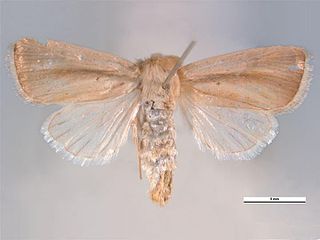
The Curculionidae are the family of the "true" weevils. They are one of the largest animal families, with 6,800 genera and 83,000 species described worldwide.

The Crambidae are the grass moth family of lepidopterans. They are quite variable in appearance, the nominal subfamily Crambinae taking up closely folded postures on grass stems where they are inconspicuous, while other subfamilies include brightly coloured and patterned insects which rest in wing-spread attitudes.

The Pyraloidea are a moth superfamily containing about 16,000 described species worldwide, and probably at least as many more remain to be described. They are generally fairly small moths.

A pheromone trap is a type of insect trap that uses pheromones to lure insects. Sex pheromones and aggregating pheromones are the most common types used. A pheromone-impregnated lure, as the red rubber septa in the picture, is encased in a conventional trap such as a bottle trap, Delta trap, water-pan trap, or funnel trap. Pheromone traps are used both to count insect populations by sampling, and to trap pests such as clothes moths to destroy them.

Chilo suppressalis, the Asiatic rice borer or striped rice stemborer, is a moth of the family Crambidae. It is a widespread species, known from India, Sri Lanka, China, eastern Asia, Japan, Taiwan, Malaysia to the Pacific.

Sesamia inferens, the Asiatic pink stem borer, gramineous stem borer, pink borer, pink rice borer, pink rice stem borer, pink stem borer, purple borer, purple stem borer or purplish stem borer, is a moth of the family Noctuidae. The species was first described by Francis Walker in 1856. It is found from Pakistan, India, Sri Lanka, Myanmar to Japan and the Solomon Islands. A polyphagous species, it is a major pest in many crops worldwide.

Chilo plejadellus, the rice stalk borer moth, is a moth in the Crambidae family described by Johann Leopold Theodor Friedrich Zincken in 1821. It is found in North America, including Illinois, Ontario, Quebec, Pennsylvania, Georgia, Louisiana, Wisconsin, Texas and Arkansas.

Polyphagozerra coffeae, the red coffee borer or coffee carpenter, is a moth of the family Cossidae. It was described by John Nietner in 1861 and is found in Asia. Records from the Moluccas and New Guinea refer to Polyphagozerra reticulata, which was previously considered to be a synonym of P. coffeae. It is a widespread pest that attacks many plants.

Scirpophaga incertulas, the yellow stem borer or rice yellow stem borer, is a species of moth of the family Crambidae. It was described by Francis Walker in 1863. It is found in Afghanistan, Nepal, north-eastern India, Sri Lanka, Bangladesh, Myanmar, Vietnam, Thailand, Malaysia, Singapore, Sumatra, Java, Borneo, Sumba, Sulawesi, the Philippines, Taiwan, China and Japan.
Chilo agamemnon is a species of moth in the family Crambidae described by Stanisław Błeszyński in 1962. It is found in Spain, Egypt, Israel, Sudan and Uganda.

Xylotrechus quadripes is a species of beetle in the family Cerambycidae. It was described by the French entomologist Auguste Chevrolat in 1863. It is well known for its habit of boring through the stems of coffee plants in plantations and is considered a pest and known by the common name coffee white stem borer. Because the larvae damage the plant while being hidden inside the woody stems, it is extremely difficult to control. The control of shade over the coffee bushes however reduces the incidence.
Chilo auricilius, the gold-fringed rice stemborer or terai borer, is a moth in the family Crambidae. It was described by Gerald C. Dudgeon in 1905. It is found in India, Taiwan, Bhutan and Sri Lanka, as well as on Sulawesi, Borneo, Sangir Island and the Moluccas. The larvae bore into and feed on the stems of various grass family plants including sugarcane, rice and maize.
Chilo infuscatellus, the yellow top borer or sugarcane shoot borer, is a moth in the family Crambidae. It was described by the Dutch entomologist Samuel Constantinus Snellen van Vollenhoven in 1890. It is found in India, Myanmar, Tajikistan, Afghanistan, Korea, Taiwan, Malaysia, the Philippines and on Java and Timor.
Chilo partellus, the spotted stalk borer, is a moth in the family Crambidae. It was described by Charles Swinhoe in 1885. It is found in India, Pakistan, Ethiopia, Lesotho, Madagascar, Malawi, South Africa, Sudan, Tanzania, Uganda and on Mayotte.
Bissetia steniellus is a moth in the family Crambidae. It was first described by the British entomologist George Hampson in 1899. It is found in India and Vietnam where it is commonly known as the Gurdaspur borer because the larvae bore their way into and feed on the stems of sugarcane.
Sturmiopsis inferens is a species of fly in the family Tachinidae. It is native to Asia and is a parasitoid of various moth species whose larvae feed inside the stems of sugarcane, rice and other large grasses, including the Gurdaspur borer and the sugarcane shoot borer.
Trichobaris trinotata, commonly known as the "potato stalk borer", is a species of weevil in the family Curculionidae. It is found in North America where it is a pest of potato plants, the larvae tunnelling inside their stems.
Cylindrocopturus adspersus, the sunflower stem weevil, is a species of true weevil in the beetle family Curculionidae. It is found in North America, where the larvae tunnel in the stems of wild and cultivated sunflower plants.













